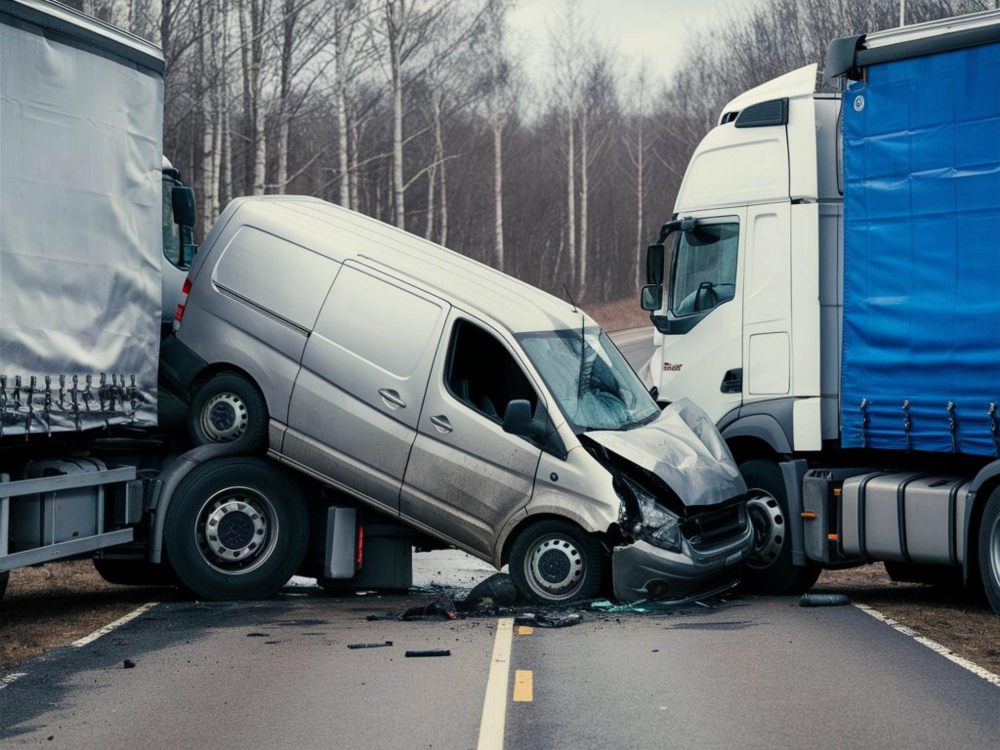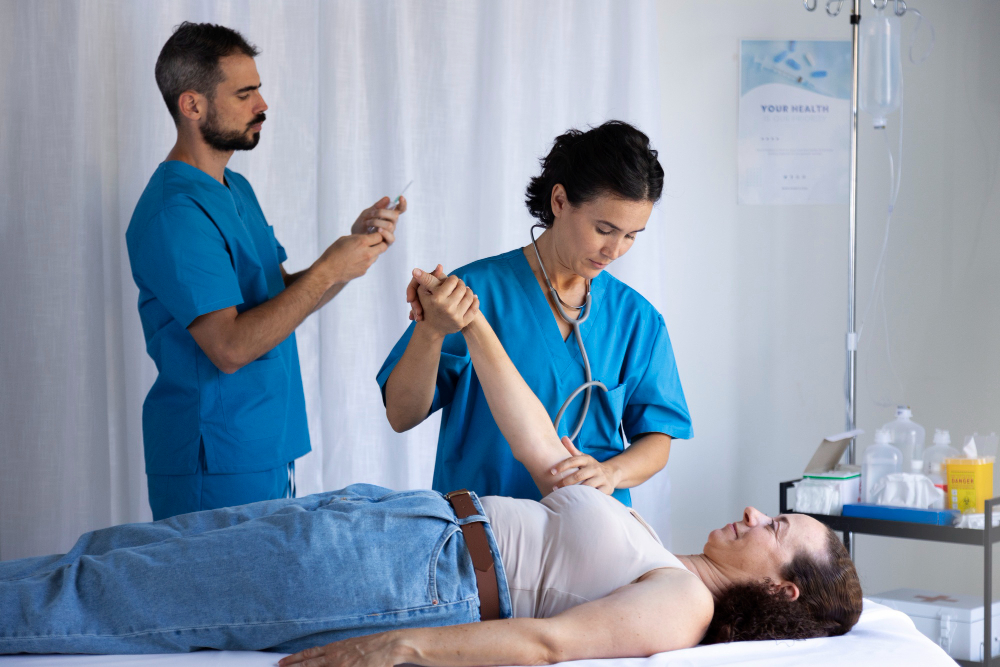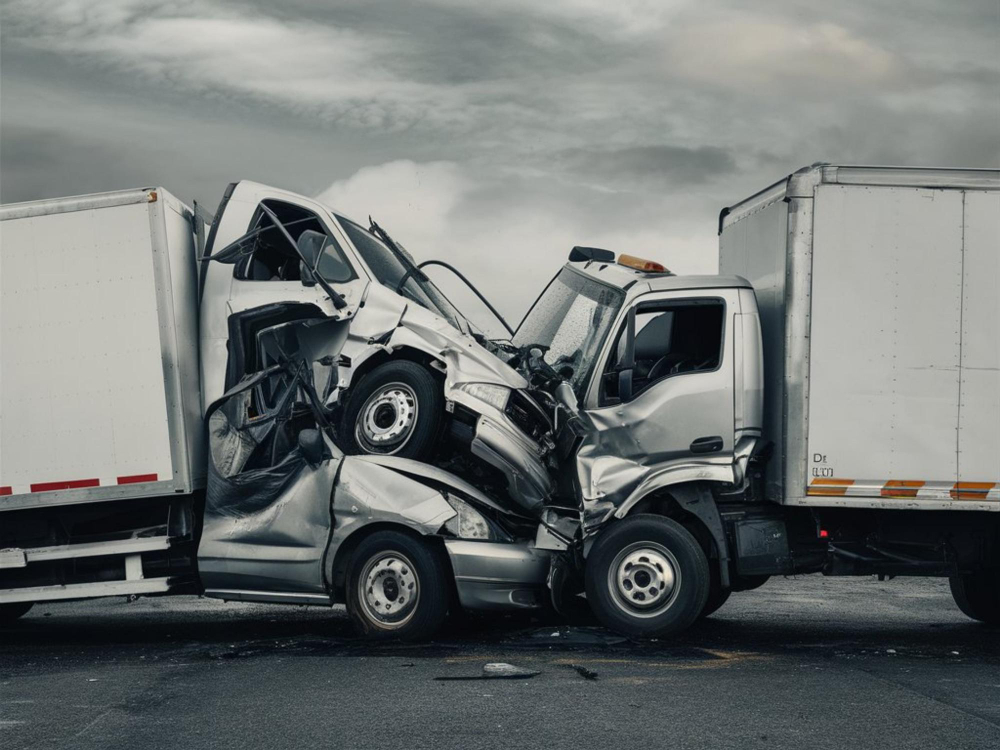Truck accidents are among the most catastrophic events on the road, often leading to devastating consequences for those involved. Due to the sheer size and weight of commercial trucks, collisions with smaller vehicles frequently result in severe injuries that can have long-lasting physical, emotional, and financial impacts. Understanding the types of injuries commonly sustained in truck accidents is crucial for prevention and preparedness.
Types Of Truck Accident Injuries
In a truck accident, injuries can vary widely depending on the circumstances and severity of the collision. Here’s a breakdown of internal and external injuries associated with truck accidents:

Internal Injuries:
Traumatic Brain Injuries (TBI)
Traumatic Brain Injuries (TBI) are a significant concern in truck accidents and other serious collisions. These injuries occur when an external force impacts the head, disrupting normal brain function.
Here are some key points about TBIs:
Types of TBIs
- Concussion: A mild form of TBI often characterized by temporary confusion, headache, and dizziness. It may or may not involve loss of consciousness.
- Contusion: A bruise on the brain’s surface, caused by direct impact to the head.
- Diffuse Axonal Injury (DAI): Widespread injury to the brain’s nerve fibers, often caused by rapid deceleration or rotational forces in accidents.
- Penetrating Injury: Occurs when an object penetrates the skull and damages brain tissue.
Symptoms
- Physical Symptoms: Headaches, nausea, vomiting, dizziness, blurred vision, sensitivity to light or sound.
- Cognitive Symptoms: Confusion, memory problems, difficulty concentrating, slowed thinking.
- Emotional and Behavioral Changes: Irritability, mood swings, anxiety, depression, changes in sleep patterns.
Spinal Cord Injuries
Spinal Cord Injuries (SCI) are another serious consequence of truck accidents and can lead to significant physical and functional impairment.
Here’s an overview of spinal cord injuries:
Types of Spinal Cord Injuries
- Complete SCI: Complete loss of sensation and motor function below the level of injury.
- Incomplete SCI: Partial loss of sensation and motor function, varying in severity depending on the extent of damage to the spinal cord.
Levels of Injury
- Cervical (neck) region: Injuries here can affect the arms, hands, trunk, legs, and pelvic organs.
- Thoracic (upper back) region: Injuries typically affect the chest, abdominal muscles, and legs.
- Lumbar (lower back) region: Injuries affect the legs, bowel, bladder, and sexual function.
- Sacral (lowest part of the spine): Injuries impact the hips, thighs, buttocks, and pelvic organs.
Symptoms
- Loss of sensation: Numbness or tingling below the injury site.
- Loss of motor function: Paralysis or weakness in affected muscles.
- Loss of bowel and bladder control: Incontinence or retention issues.
- Difficulty breathing: Depending on the level and severity of the injury.
Organ Damage
Organ damage in the context of a truck accident can be severe and life-threatening. It refers to any injury that affects the internal organs due to the force and impact of the collision.
Here are some common types of organ damage that can occur:
- Internal Bleeding: This occurs when blood vessels inside the body are damaged, leading to blood leaking into surrounding tissues or body cavities. It can be difficult to detect initially but can be life-threatening if not treated promptly.
- Punctured Organs: Organs such as the liver, spleen, kidneys, or intestines can be punctured or lacerated by broken bones, penetrating objects, or the force of impact. These injuries often require surgical intervention to repair.
- Crushed Organs: In severe collisions, organs can be crushed between bones or against other structures in the body, leading to significant damage and sometimes irreversible injury.
- Contusions and Hematomas: Blunt force trauma can cause contusions (bruises) on organs or hematomas (collections of blood outside blood vessels), which can impair organ function and lead to complications.
- Functional Impairment: Even without visible damage, the functioning of organs like the heart, lungs, or kidneys can be impaired due to the stress and shock of the accident, requiring monitoring and medical intervention.
Crush Injuries
Crush injuries occur when a part of the body is subjected to intense pressure or compression, often in accidents involving heavy machinery or vehicles like trucks.
Here are some key points about crush injuries:
Causes
- Accidents: Such as being caught between two objects, like a vehicle and a solid surface, or
being pinned by heavy equipment. - Natural Disasters: Collapse of buildings or structures during earthquakes, hurricanes, etc.
Industrial Accidents: Involving machinery or equipment malfunction.
Types of Injuries
- Soft Tissue Injury: Damage to muscles, tendons, and ligaments due to compression.
Bone Fractures: Breaks or splintering of bones under pressure. - Compartment Syndrome: Swelling within a muscle compartment can lead to reduced blood flow and nerve damage.
- Crush Syndrome: A serious condition that can occur when large amounts of muscle tissue break down due to prolonged compression, releasing toxins into the bloodstream and potentially leading to kidney failure and other systemic complications.
Whiplash
Whiplash is a common injury that occurs when the head and neck are suddenly forced backward and then forward, similar to the cracking of a whip. It is frequently associated with rear-end car collisions but can also occur during sports accidents or falls.
Symptoms of Whiplash:
- Neck Pain and Stiffness: The primary symptom is often neck pain that may worsen with movement.
- Headaches: Often felt at the base of the skull and may radiate towards the forehead.
- Shoulder and Upper Back Pain: Pain and stiffness in the shoulders and upper back are common due to the neck muscles being strained.
- Dizziness and Fatigue: Some people experience dizziness, fatigue, or difficulty concentrating.
- Other Symptoms: Numbness or tingling in the arms, blurred vision, and ringing in the ears can also occur.
External Injuries
Lacerations
Lacerations are cuts or tears in the skin and underlying tissue caused by a sharp object or forceful impact. In the context of a truck accident, lacerations can occur due to broken glass, metal fragments, or contact with objects inside the vehicle or on the road.
Here are some key points about lacerations:
- Causes: Lacerations in a truck accident can be caused by shattered windshield glass, metal edges, debris, or impact with interior components like dashboards or seats.
- Severity: Lacerations can range from minor cuts that require simple cleaning and bandaging to deep wounds that may involve significant bleeding and tissue damage.
Abrasions
Abrasions, also known as scrapes or road rash, are superficial injuries to the skin caused by friction or rubbing against a rough surface. In the context of a truck accident, abrasions can occur when a person’s skin contacts the road, vehicle surfaces, or other rough objects during the collision.
Here are some key points about abrasions:
- Causes: Abrasions in a truck accident can result from contact with pavement, gravel, metal surfaces, or debris. They typically occur when skin is scraped or dragged across a rough or abrasive surface.
- Appearance: Abrasions appear as shallow wounds with scrapes or grazes on the outer layer of the skin. They may range from mild redness and irritation to deeper wounds that expose underlying layers of skin.
Burns
Burn injuries in truck accidents can result from various factors, such as fires, explosions, or contact with hot surfaces. Here are some key points about burns in the context of truck accidents:
Types of Burns
- Thermal Burns: These are the most common and occur due to contact with flames, hot surfaces, or heated objects during a truck accident.
- Chemical Burns: Exposure to hazardous chemicals or substances carried by the truck can cause chemical burns on the skin or internally if inhaled or ingested.
- Electrical Burns: In accidents involving power lines or electrical equipment on the truck, electrical burns can occur due to contact with live wires or electrical currents.
Severity of Burns
Burns are classified into degrees based on their severity:
- First-Degree Burns: Affect the outer layer of skin (epidermis) and cause redness, pain, and swelling.
- Second-degree burns: Involve both the outer layer and the underlying layer of skin (dermis), causing blisters, severe pain, and possible scarring.
- Third-degree burns: The most severe type, affecting deeper tissues, nerves, and even bones. The skin may appear charred or white, and the damage can be extensive, often requiring skin grafts and long-term medical care.
Bruises
Bruises are common injuries in truck accidents and other types of collisions. They occur when small blood vessels under the skin rupture due to blunt force trauma, causing blood to leak into the surrounding tissues.
Here are some key points about bruises:
- Appearance: Bruises often appear as dark, discolored areas on the skin, ranging from blue or purple to yellow or green as they heal.
- Causes: In truck accidents, bruises can result from impact with seat belts, airbags, steering wheels, or other objects inside the vehicle. They can also occur from contact with external objects during the accident.
- Symptoms: bruises are tender to the touch and may be accompanied by swelling or mild pain at the site of injury.
Fractures and Traumatic Amputations
Fractures and traumatic amputations are significant injuries that can occur in truck accidents due to the force and impact involved.
Here’s more detail on each:
Fractures
Fractures, or broken bones, can vary in severity depending on the force of the impact and the area of the body affected.
In truck accidents, common types of fractures include:
- Long Bone Fractures: These are fractures in the long bones of the body, such as the femur (thigh bone), tibia and fibula (lower leg bones), humerus (upper arm bone), and radius and ulna (forearm bones).
- Compression Fractures: Often seen in the spine due to the impact of the collision, which can lead to fractures in vertebrae.
- Compound Fractures: Where the bone breaks through the skin, potentially leading to infections and complications.
- Stress Fractures: These can occur due to repetitive stress or sudden trauma, often affecting weight-bearing bones like those in the legs and feet.
Traumatic Amputations
Traumatic amputations involve the partial or complete loss of a body part due to severe injury. In truck accidents, these injuries can happen when body parts are crushed or severed during the collision.
Commonly affected areas include:
- Limbs: Arms, legs, hands, and feet are vulnerable to traumatic amputations in accidents where there is significant force or crushing injuries.
- Digits: Fingers and toes can also be amputated or severely damaged in truck accidents.
Treatment for Truck Accident Injuries

- Emergency Care: Immediate medical attention is crucial for severe injuries sustained in truck accidents. Paramedics provide on-site stabilization, including controlling bleeding, immobilizing fractures, and ensuring airway and breathing support.
- Hospitalization: Victims are often transported to hospitals for further evaluation and treatment, which may involve surgery for internal injuries, fractures, or traumatic amputations.
- Surgical Interventions: Depending on the injury, surgeries can range from setting and stabilizing broken bones to repairing internal organ damage or performing amputations.
- Rehabilitation: Post-surgery, rehabilitation is essential for recovery. This includes physical therapy to restore mobility and strength, occupational therapy to regain daily functioning, and psychological support to address trauma and mental health issues.
- Pain Management: Pain relief is managed through medications, nerve blocks, or other therapies to ensure comfort during recovery.
- Follow-Up Care: Regular medical follow-ups are necessary to monitor healing, manage any complications, and adjust treatments as needed. Comprehensive care plans tailored to individual needs ensure the best possible recovery outcomes for truck accident victims.
FAQs
1. What should I do immediately after a truck accident?
Seek medical attention immediately, even if you feel fine. Adrenaline can mask symptoms of serious injuries. Call emergency services and get a thorough evaluation from medical professionals.
2. What types of injuries are common in truck accidents?
Common injuries include fractures, traumatic amputations, soft tissue injuries, traumatic brain injuries, spinal cord injuries, and internal organ damage.
3. How are fractures treated after a truck accident?
Treatment may involve immobilization with casts or braces, pain management, and surgery to set and stabilize the bones. Physical therapy is often required for recovery.
4. What is the treatment for traumatic amputations?
Immediate treatment includes controlling bleeding and preventing infection. Surgery may be necessary to clean the wound and possibly reconstruct the limb. Rehabilitation and prosthetics are part of long-term care.
5. How are soft tissue injuries managed?
Soft tissue injuries are treated with rest, ice, compression, and elevation (RICE), along with pain management and physical therapy. Severe cases may require surgical intervention.




